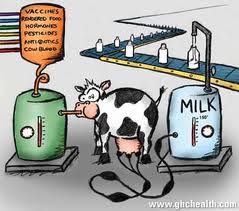Genetically engineered crops have provided “substantial” environmental and economic benefits to American farmers, but overuse of the technology is threatening to erode the gains, a national science advisory organization said Tuesday in a report.
The report is described as the first comprehensive assessment of the impact of genetically modified crops on American farmers, who have rapidly adopted them since their introduction in 1996. The study was issued by the National Research Council, which is affiliated with the National Academy of Sciences and provides advice to the nation under a Congressional charter.
The report found that the crops allowed farmers to either reduce chemical spraying or to use less harmful chemicals. The crops also had lower production costs, higher output or extra convenience, benefits that generally outweighed the higher costs of the engineered seeds.
“That’s a long and impressive list of benefits these crops can provide, and have provided to adopting farmers,” David E. Ervin, the chairman of the committee that wrote the report, said on Tuesday during a webcast news conference from Washington.
But Dr. Ervin, a professor of environmental management and economics at Portland State University in Oregon, warned that farmers were jeopardizing the benefits by planting too many so-called Roundup Ready crops. These crops are genetically engineered to be impervious to the herbicide Roundup, allowing farmers to spray the chemical to kill weeds while leaving the crops unscathed.
Overuse of this seductively simple approach to weed control is starting to backfire. Use of Roundup, or its generic equivalent, glyphosate, has skyrocketed to the point that weeds are rapidly becoming resistant to the chemical. That is rendering the technology less useful, requiring farmers to start using additional herbicides, some of them more toxic than glyphosate.
“Farmer practices may be reducing the utility of some G.E. traits as pest-management tools and increasing the likelihood of a return to more environmentally damaging practices,” the report concluded. It said the problem required national attention.
More than 80 percent of the corn, soybean and cotton grown in the United States is genetically engineered. The crops tolerate Roundup, are resistant to insects, or both.
American farmers were the first to widely adopt the technology and still account for about half of all the engineered crops grown. The crops are also being widely grown in Latin America and parts of Asia but are still largely shunned in Europe.
The rapid adoption of the crops is evidence that American farmers see the technology as beneficial.
Critics of biotechnology, who say the crops may be risky to health and the environment, have issued studies saying that use of the crops has resulted in increased reliance on pesticides and has had only a minimal effect on crop yields.
The National Research Council report, more than 200 pages, was prepared by a committee of mainly academic scientists, and it relied primarily on peer-reviewed papers.
Still, the report is not likely to win over critics of the crops.
One critic, Charles Benbrook, said the conclusion that the crops help farmers might not be true in the future. That is because the report relies mostly on data from the first few years, before prices of the biotech seeds rose sharply and the glyphosate-resistant weeds proliferated.
“This is a very different future,” said Dr. Benbrook, an agricultural economist who is chief scientist at the Organic Center, which promotes organic food and farming. “The cost is going to be way higher. The environmental impacts are going to go up fairly dramatically.”
As prices of the biotech seeds have risen sharply, even some farmers are now starting to question whether they are worth it. Just last week, Monsanto, the leading agricultural biotechnology company, said it would lower the prices of its newest genetically engineered soybeans and corn seeds because farmers were not buying as many as it had expected.
The Justice Department is investigating whether Monsanto, which has patents on the Roundup Ready system, is violating antitrust laws, unduly increasing prices or hindering innovation.
The National Research Council report addresses this issue briefly without mentioning Monsanto. It says that patent licensing terms have “not adversely affected the economic welfare of farmers who adopt G.E. crops.” But it said there was some evidence that the availability of nonengineered crops “may be restricted for some farmers.”
Monsanto, in a statement, said the report “affirms what farmers know — that agricultural biotechnology has delivered substantial environmental and economic benefits.” It said it was working with farmers to help manage and monitor herbicide-resistant weeds.
Shares of Monsanto, which have been falling since January, slipped nearly 2 percent Tuesday to $67.75.
The report said that the use of Roundup Ready crops had led to a huge increase in the spraying of glyphosate but a nearly equal decrease in the use of other herbicides. That is a net environmental benefit, the report said, because glyphosate is less toxic to animals than many other herbicides and does not last long in the environment.
The report compared genetically modified crops with the conventionally grown crops they replaced, not to organic crops.
The use of herbicide-tolerant crops has also made it easier for farmers to forgo tilling as a way to control weeds. So-called no-till farming helps prevent soil erosion and the runoff of rainwater containing sediments and chemicals. The improvement in water quality could prove to be the largest benefit of the crops, the report said, though it added that efforts should be made to measure any such effects.
The other major class of genetically engineered crops consists of the so-called BT corn and BT cotton, which contain bacterial genes allowing the plants to produce an insecticide.
The report said that use of chemical insecticides had declined as BT crops had spread. In areas with heavy insect pressure, it said, the use of the crops has increased farmer income because of higher yields and reduced spending on insecticide.
The report said that when genetically engineered crops were introduced, some had lower yields than conventional varieties, a finding often cited by critics. But the report said newer studies showed either a modest increase in yield or no effect.
Chuck Myers, a corn and soybean farmer from Nebraska who was not involved in the report, said that even if biotechnology had not increased the intrinsic yield potential of the crops, “If you’re controlling a pest, you’re preserving your yield.”




